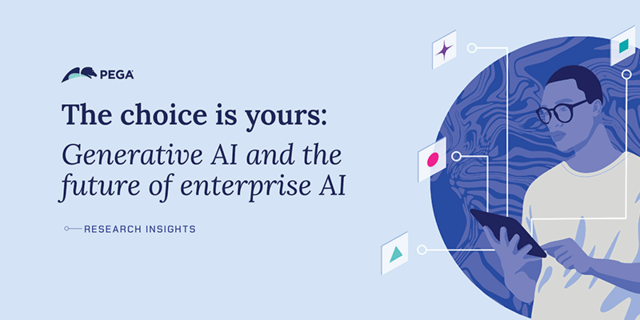Over 90% of enterprise organizations are planning to increase their use of AI within the next five years. That’s according to Pega’s latest research report, “The choice is yours: Generative AI and the future of enterprise AI.”
While this number spans across industries and regions, there’s good reason for contact center leaders to notice. Gen AI has already started making its way into customer service – indeed, the contact center may be the most fertile ground for enterprise AI to take root and yield value to the organization.
Let’s take a closer look at the implications AI will have on customer service, including the art of the possible and the ways organizations should prepare themselves for this impending revolution.
The current landscape and strategic implementation of AI
The organizations we talk to know that AI is going to be transformational. What’s less clear to them is exactly how and where this transformation will take place. As it stands, contact centers still struggle with high agent workloads, shifting customer expectations, employee turnover, long wait times, and resource crunch. The best way to implement AI strategically will depend somewhat on the particular mix of issues any given organization faces and that organization’s level of digital maturity.
But what’s going to hold true across the customer service landscape is that gen AI is best deployed as part of a broader digital transformation strategy – integrated into decisions about platforms, tool stacks and strategies, not rolled out as a standalone tool. The technology will deliver the most value as a key component of an array of interconnected systems.
Take another statistic surfaced in the eBook: More respondents said they would trust a human over an AI (15% to 7% – no surprise there). But 37% said they would trust AI overseen by a human, while 41% would most trust a human with assistance from AI when it came to building customer relationships. As a tool in the agent’s kit, AI stands to completely transform what’s possible.
Where will AI have the most immediate impact in customer service?
The most exciting initial use cases of AI in the contact center touch every part of the customer journey – from self-service to the agent experience to the workflows that drive how things get done. Importantly, none of these involve replacing human agents with AI wholesale. But they do involve changing the processes that often prevent seamless interactions from occurring.
AI is poised to enhance the customer and agent experience by augmenting human capabilities and removing manual, repetitive work from the desk. This is technology available today: Things like automating wrap-up, delivering knowledge and answering questions contextually, suggesting responses, next-best-action offers, and bundles. These and other features alleviate the cognitive load customer service reps face and enable them to focus on the customer instead of the system.
Additionally, AI can help orchestrate work across the back office and coordinate interactions across channels. Customers have different channel preferences, and many customers use multiple channels – even over the course of a single inquiry, often moving from self-service chat to a phone call to an email follow-up. It’s important for contact centers to be able to effectively triage, route, track, and coordinate inquiries that cross channels.
Building trust and overcoming challenges
If the technology is there, and the desire to implement AI broadly across customer service is there, then what are some of the things that could prove to be stumbling blocks for enterprises looking to start rolling this out?
Two mistakes we often hear when we talk to enterprise organizations about integrating AI are as follows:
- Trying to build a solution in-house. Undoubtedly, many organizations have the technical ability to stand up a tool that relies on publicly available LLMs. But the work, effort, time, and expertise involved means the ends don’t justify the means – especially when existing off-the-shelf options are available to license today.
- Licensing (or building) a solution that is not enterprise-ready. Anything you introduce into your ecosystem should be able to scale securely and with the proper governance in place, without sacrificing the agility necessary to make changes and adapt on the fly.
In addition, it will be crucial to build trust and get buy-in among employees. That starts with showing how the technology will make their jobs easier – by automating more tedious work, for instance.
As the research report explains, human oversight is also a key component to building trust and ensuring AI is doing its job: “Make sure that at every stage, everything AI does is transparent and explainable, with a human present to oversee and, if necessary, intervene to make sure it provides the best possible results.”
The AI-powered service revolution
As customer service transitions into an era defined in part by AI, some may be surprised at how familiar and intuitive it will look. Don’t expect customers to stop reaching out with issues and inquiries. Don’t expect agents to hand the reigns over to AI chatbots in full. Instead, expect faster resolutions, more capable agents, fewer low-touch inquiries that make it to the service desk, and more automated workflows with fewer manual tasks. AI is there to grease the wheels of every service interaction while opening the door to transformative changes in how work gets done.
To get started, CS leaders should partner with experienced, trusted vendors to identify the low-hanging fruit – in terms of workflows, use cases, and high-priority needs – and devise a plan that targets those areas with AI-powered tools that make sense and integrate with existing systems.
In the meantime, download the Research Insights here to understand the full outlook on AI for the enterprise and find out how it is poised to enable true transformation for customer service and beyond.

